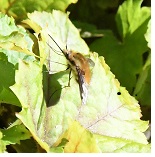Nature Notes April 2020
Date Published: 02-05-2020
This was the sunniest April since records began. Only in the last week did a change take place, turning to showery periods with wind and a hail storm.
SIGHTINGS
Birds (seen or heard): Carrion Crows, Magpies, Buzzards, Heron, Green/great Spotted Woodpeckers, Tawny Owls, Sparrowhawk, Wood Pigeons, Stock Doves, Collared Doves, Nuthatches, Treecreepers, Wrens, Goldcrest, Blackcaps, Chiffchaffs, Willow Warblers, Cuckoo, Blackbirds, Song Thrushes, Robins, Dunnocks, Greenfinches, Goldfinches, Chaffinches, Bullfinches, Siskins, Stonechats, Coal/Blue/Great/Long-tailed Tits.
Insects: Midges, Wasps, Hover Flies, Flies, Buff-tailed Bees, Large bee-fly, Wood Lice, Centipedes, Ants.
Mammals: Grey Squirrels, Mole activity, Fox, Wood Mice, Roe Deer, Badger activity, Hedgehogs.
Plants in flower/berry: Holly, Ivy, Viburnum, Common Gorse, Laurel, Flowering Currant, Amelanchier, Catkins, Rowan, Bluebells, Blackberries, Cut-leaved Geranium, Yellow Flag Iris, Zantedeschia (White Arum), Dandelion.
Pond Life: Pond Skaters, Whirlygig Beetles.
Butterflies: Brimstones, Peacocks, Comma, Holly Blue, Orange Tip, Large White.
Damselfly: Small Red.
Although at the beginning of the month the birds were busy with courting and nest building, activity grew calmer, with not so much movement, as the females laid eggs and began to sit.
The Tawny Owls were very vocal on warm evenings.
Blackcaps, Chiffchaffs and Willow warblers have all arrived on site and were frequently seen and heard.
In the last week of the month, a Cuckoo was heard calling at the Eastern end of the site.
Yellow Flag Irises and the large White Arum were seen by the west bridge, Kingfisher Creek.
NATURE FACT
The Large bee-fly is an attractive insect that can be seen hovering from April to June in wooded areas with sunny clearings. It is 10 – 12 mm long with a brown, furry, bee-like coat, a long proboscis, a dark leading edge to it’s wings and with long slender legs. It hovers, using its long front legs to steady itself as it reaches for nectar with its proboscis. The larvae are parasitic on solitary bees and wasps. It is completely harmless to humans.
Recorder: C.Wilcox





